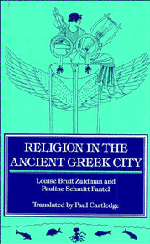Book contents
- Frontmatter
- Contents
- List of illustrations
- Author's preface to the English translation
- Translator's introduction
- List of sources
- PART I Introduction: How should we study Greek civic religion?
- PART II Cult-practices
- PART III Systems for representing the divine
- 12 Myths and mythology
- 13 A polytheistic religion
- 14 Forms of imaginative projection
- PART IV Envoi
- Appendixes
- Bibliography
- Index
12 - Myths and mythology
Published online by Cambridge University Press: 05 June 2012
- Frontmatter
- Contents
- List of illustrations
- Author's preface to the English translation
- Translator's introduction
- List of sources
- PART I Introduction: How should we study Greek civic religion?
- PART II Cult-practices
- PART III Systems for representing the divine
- 12 Myths and mythology
- 13 A polytheistic religion
- 14 Forms of imaginative projection
- PART IV Envoi
- Appendixes
- Bibliography
- Index
Summary
DEFINITIONS OF MYTH AND MYTHOLOGY
What is labelled collectively as ‘myth’ can, in the context of ancient Greece, assume the most diverse forms depending on the way it is preserved and represented. On one level, for example, there are the myths of the specialist ancient mythographers or the scattered fragments collected in lexicographers' glosses. At another level, there are the literary reworkings of myth to be found in epic, tragedy and lyric poetry. Or, thirdly, there are compositions with an explicitly theological purpose such as theogonies (divine genealogies). Then, finally, there are the figural representations (to be considered in chapter 14). It is this mass of disparate discourses that modern mythologers attempt to decipher, using a variety of methods and procedures (see next section).
The very concept of myth has been transmitted to us by the Greek tradition itself. At an early period muthos meant any ‘spoken word’ and so belonged to the general category of logos or ‘that which is said’. But logos progressively came to mean not only that, but, more specifically, persuasive utterance that appealed to the rational intelligence and to the concept of ‘truth’. Thus an opposition developed between logos, in this sense of rational discourse, and muthos, which now bore the twofold connotation of untruth and irrationality.
- Type
- Chapter
- Information
- Religion in the Ancient Greek City , pp. 143 - 175Publisher: Cambridge University PressPrint publication year: 1992



